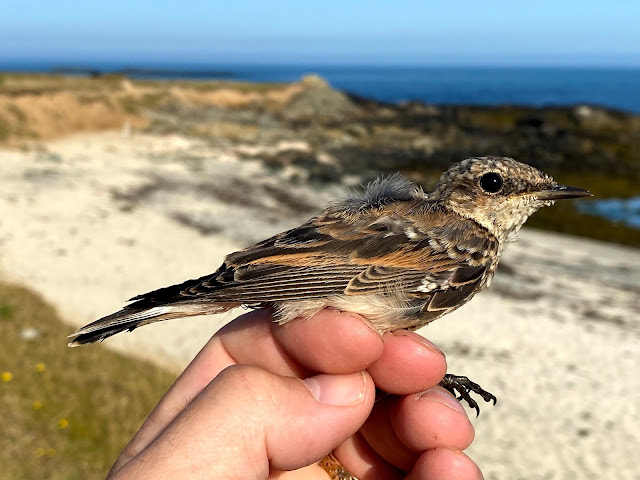Stuart began his day trying to trap Wheatears on the Narrows. A couple of Dunlin were on Solfach, and Curlew numbers had increased slightly.
Steve began census at the Obs and heard a few Swifts overhead, but there was little of note in the garden. After wandering over Pen Cristin and along to the narrows to see Stuart and a young Wheatear he had trapped he carried on his census route.
 |
| Juvenile Wheatear |
After walking along the West Coast and up through the withies, and heading back to the Obs for 'moth o’ clock' with the guests (10am), he stopped briefly in Cristin Withy scribbling notes into his notebook. Suddenly, a large yellow and black hornet flew past him, giving him a shock initially, then he realised that it was not a Hornet at all, but an absolutely striking moth. It was in fact a Lunar Hornet Moth. Then there was a second… and a third, all being attracted to the pheromones being given off by a mating pair deep in the undergrowth! Upon realising that this was the very much sought after moth, a member of the clearwing family, Steve began to get rather excited!
 |
| Lunar Hornet |
Once he had stopped hyperventilating and calmed down, he ran back to the Obs to tell others. This is only the third time this fantastic hornet mimic has been recorded on the island - There is a record from 7 July 1984 and then on 6 July 1992, at least ten adults were discovered in the withies.
These fantastic creatures are masters of what is known as Batesian mimicry. This is a form of optical mimicry where a harmless species in this case a moth, has evolved to imitate the warning signals of a harmful species directed at a predator of them both in this case a Hornet. It is named after the English naturalist Henry Walter Bates, and his groundbreaking work on butterflies in the Brazilian rainforests.
 |
| Lunar Hornet Moth |
 |
| Mating pair of Lunar Hornet moths |
 |
| Elderberry Pearl |
 |
| Small Rivulet |
 |
| Buff Arches - such a beautiful and intricately marked moth |
 |
| Peach Blossom |
 |
| Garden Tigers - note the variation in the upper wing pattern |
Steve then continued the north census areas and found that there were loads of butterflies too, just shy of 100 Green Veined Whites, 63 Meadow Browns, and a few Grayings again.
Bird wise, there was little of note on the migrant front other than a couple of Willow Warblers at Nant, however best bird of the day was found by Emma as she was working at the Obs and she noticed a quite smart looking Black Redstart in the courtyard.



No comments:
Post a Comment